Organisation and Behaviour Report: Leadership, Culture, and Structure
VerifiedAdded on 2019/12/18
|14
|4520
|660
Report
AI Summary
This report delves into the core concepts of organizational behavior, examining the interplay between organizational culture, structure, and employee conduct. It explores different organizational structures like tall and flat hierarchies, and cultures such as power, role, task, and person cultures, alongside the influence of artifacts, espoused values, and underlying assumptions. The report further investigates leadership styles, including autocratic, democratic, and laissez-faire approaches, and their connection to organizational theories like classical, neoclassical, contingency, and systems theories. It analyzes factors influencing employee behavior, both internal (leadership, structure, culture) and external (technology, social and political changes). The report also assesses the impact of leadership styles and motivational theories on staff behavior, and explores the dynamics of groups, teamwork, and the influence of technology on organizational performance, using City College and car rental Enterprise as case studies. The report highlights the significance of a positive work environment and its contribution to employee satisfaction and organizational success.
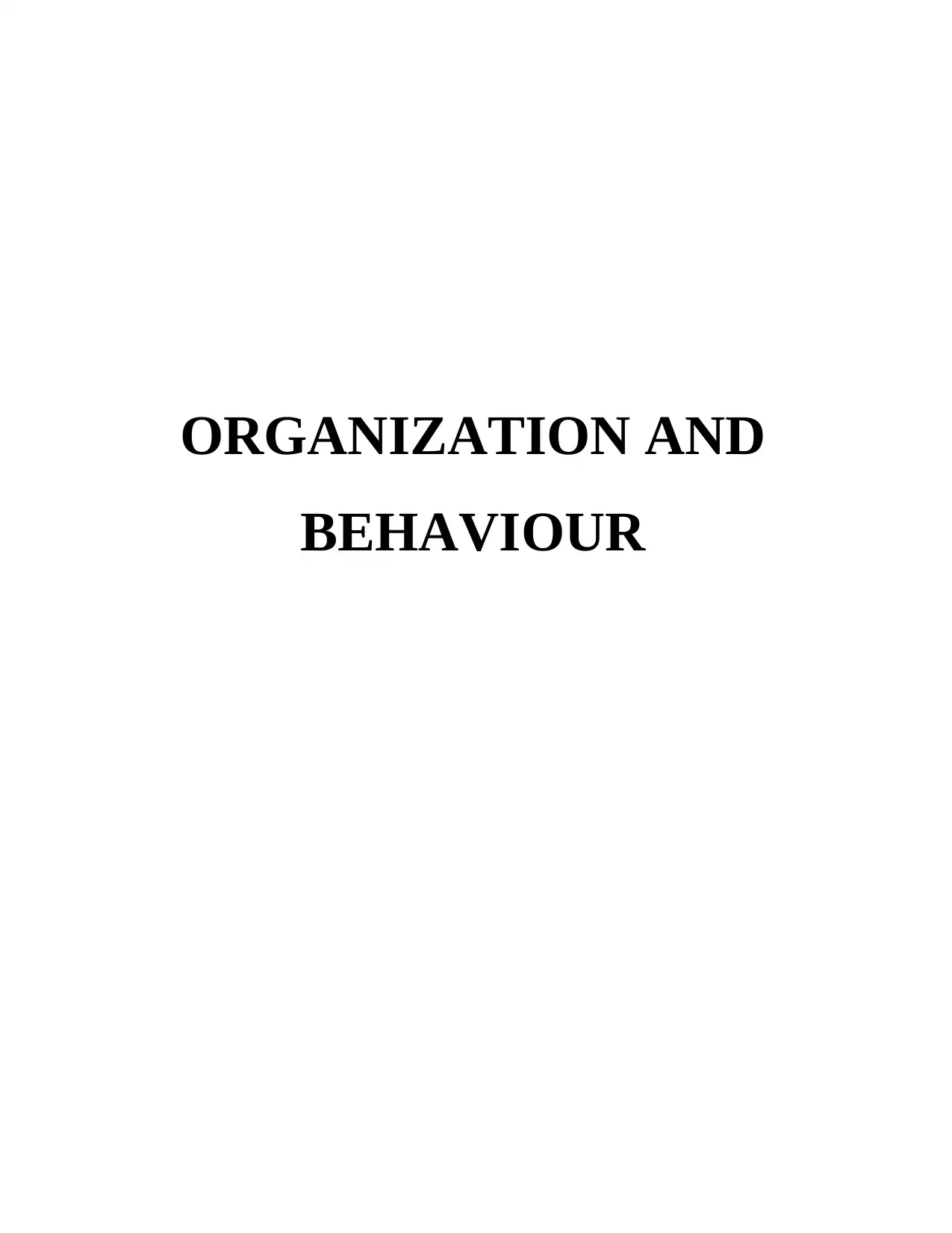
ORGANIZATION AND
BEHAVIOUR
BEHAVIOUR
Paraphrase This Document
Need a fresh take? Get an instant paraphrase of this document with our AI Paraphraser
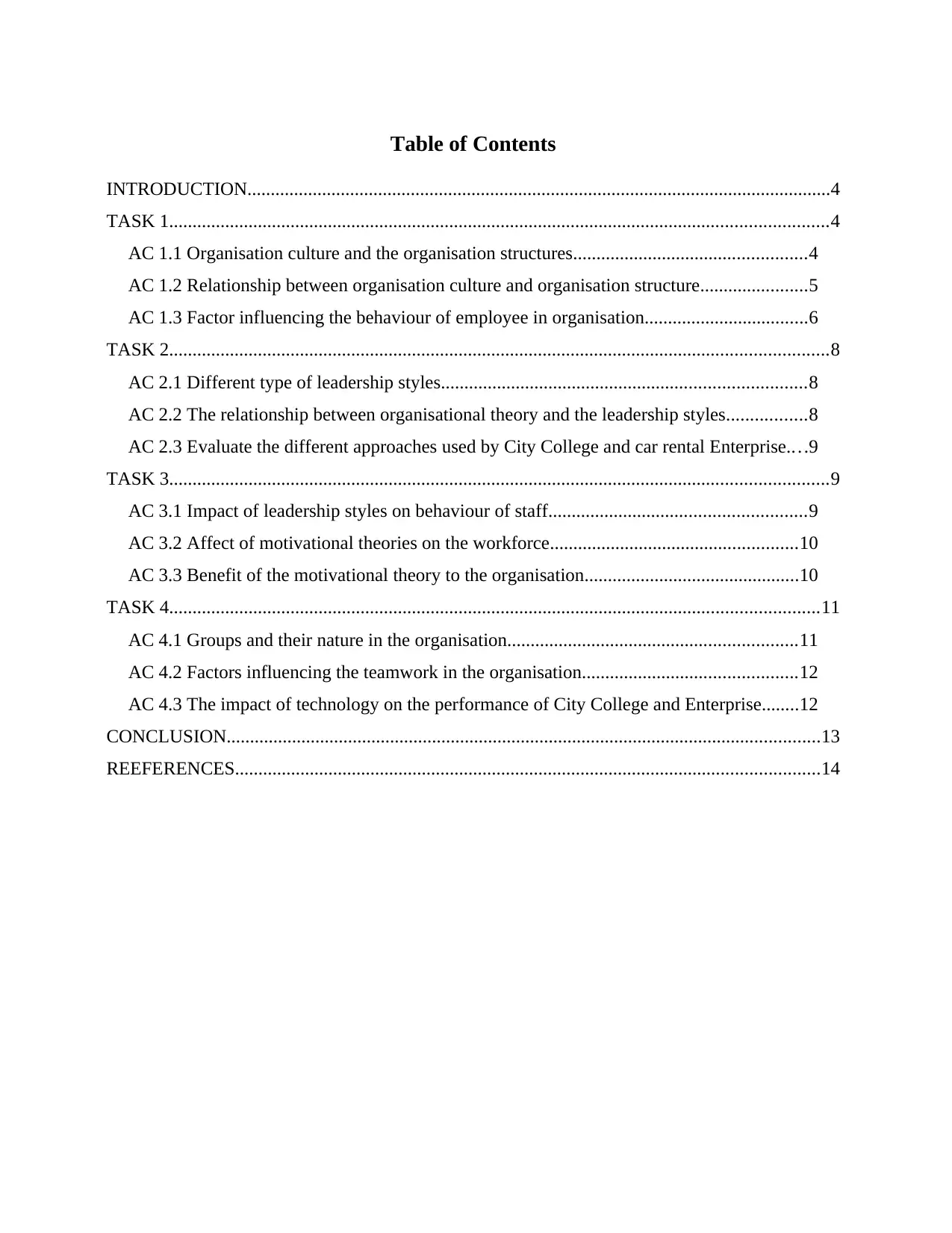
Table of Contents
INTRODUCTION.............................................................................................................................4
TASK 1.............................................................................................................................................4
AC 1.1 Organisation culture and the organisation structures..................................................4
AC 1.2 Relationship between organisation culture and organisation structure.......................5
AC 1.3 Factor influencing the behaviour of employee in organisation...................................6
TASK 2.............................................................................................................................................8
AC 2.1 Different type of leadership styles..............................................................................8
AC 2.2 The relationship between organisational theory and the leadership styles.................8
AC 2.3 Evaluate the different approaches used by City College and car rental Enterprise....9
TASK 3.............................................................................................................................................9
AC 3.1 Impact of leadership styles on behaviour of staff.......................................................9
AC 3.2 Affect of motivational theories on the workforce.....................................................10
AC 3.3 Benefit of the motivational theory to the organisation..............................................10
TASK 4...........................................................................................................................................11
AC 4.1 Groups and their nature in the organisation..............................................................11
AC 4.2 Factors influencing the teamwork in the organisation..............................................12
AC 4.3 The impact of technology on the performance of City College and Enterprise........12
CONCLUSION...............................................................................................................................13
REEFERENCES.............................................................................................................................14
INTRODUCTION.............................................................................................................................4
TASK 1.............................................................................................................................................4
AC 1.1 Organisation culture and the organisation structures..................................................4
AC 1.2 Relationship between organisation culture and organisation structure.......................5
AC 1.3 Factor influencing the behaviour of employee in organisation...................................6
TASK 2.............................................................................................................................................8
AC 2.1 Different type of leadership styles..............................................................................8
AC 2.2 The relationship between organisational theory and the leadership styles.................8
AC 2.3 Evaluate the different approaches used by City College and car rental Enterprise....9
TASK 3.............................................................................................................................................9
AC 3.1 Impact of leadership styles on behaviour of staff.......................................................9
AC 3.2 Affect of motivational theories on the workforce.....................................................10
AC 3.3 Benefit of the motivational theory to the organisation..............................................10
TASK 4...........................................................................................................................................11
AC 4.1 Groups and their nature in the organisation..............................................................11
AC 4.2 Factors influencing the teamwork in the organisation..............................................12
AC 4.3 The impact of technology on the performance of City College and Enterprise........12
CONCLUSION...............................................................................................................................13
REEFERENCES.............................................................................................................................14
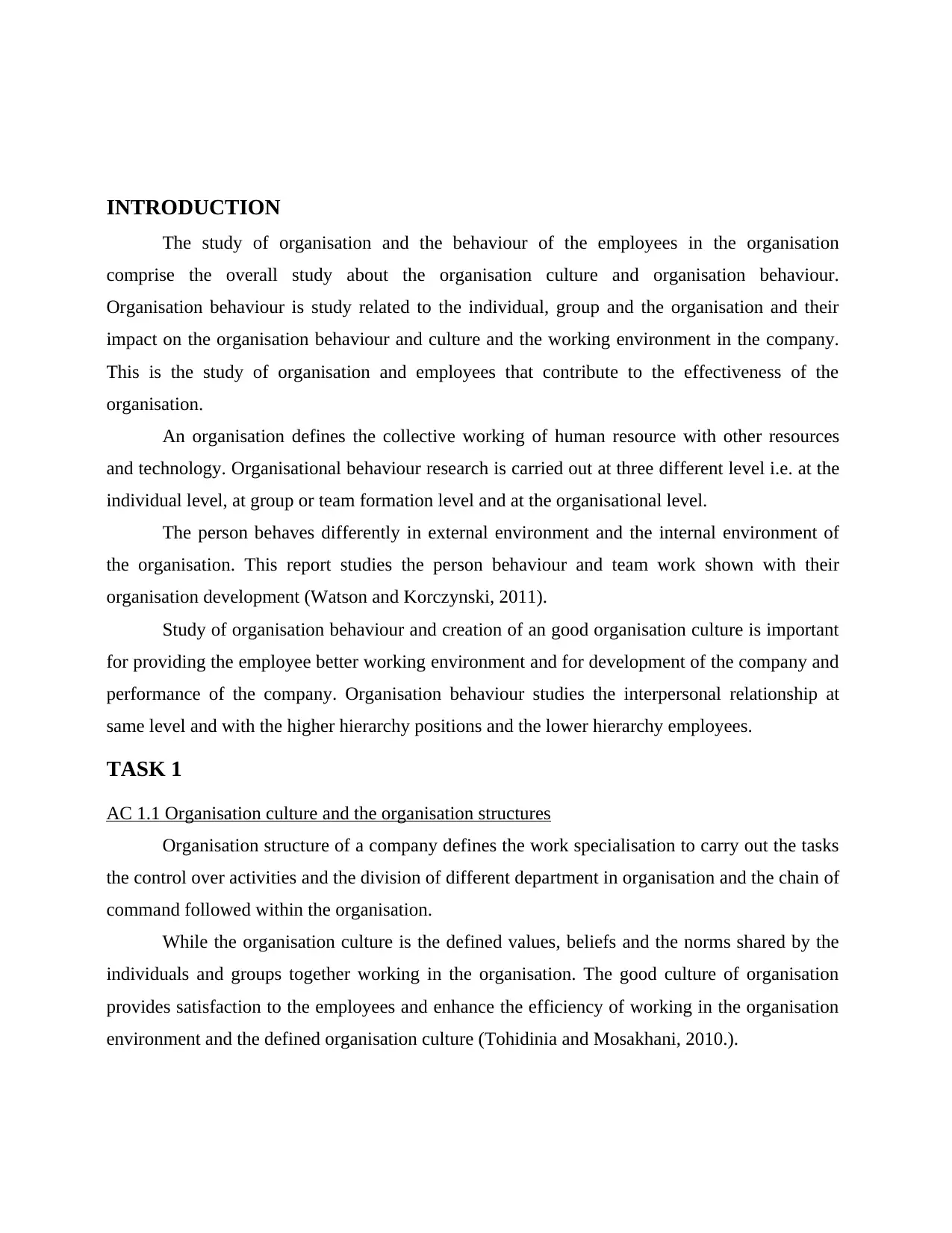
INTRODUCTION
The study of organisation and the behaviour of the employees in the organisation
comprise the overall study about the organisation culture and organisation behaviour.
Organisation behaviour is study related to the individual, group and the organisation and their
impact on the organisation behaviour and culture and the working environment in the company.
This is the study of organisation and employees that contribute to the effectiveness of the
organisation.
An organisation defines the collective working of human resource with other resources
and technology. Organisational behaviour research is carried out at three different level i.e. at the
individual level, at group or team formation level and at the organisational level.
The person behaves differently in external environment and the internal environment of
the organisation. This report studies the person behaviour and team work shown with their
organisation development (Watson and Korczynski, 2011).
Study of organisation behaviour and creation of an good organisation culture is important
for providing the employee better working environment and for development of the company and
performance of the company. Organisation behaviour studies the interpersonal relationship at
same level and with the higher hierarchy positions and the lower hierarchy employees.
TASK 1
AC 1.1 Organisation culture and the organisation structures
Organisation structure of a company defines the work specialisation to carry out the tasks
the control over activities and the division of different department in organisation and the chain of
command followed within the organisation.
While the organisation culture is the defined values, beliefs and the norms shared by the
individuals and groups together working in the organisation. The good culture of organisation
provides satisfaction to the employees and enhance the efficiency of working in the organisation
environment and the defined organisation culture (Tohidinia and Mosakhani, 2010.).
The study of organisation and the behaviour of the employees in the organisation
comprise the overall study about the organisation culture and organisation behaviour.
Organisation behaviour is study related to the individual, group and the organisation and their
impact on the organisation behaviour and culture and the working environment in the company.
This is the study of organisation and employees that contribute to the effectiveness of the
organisation.
An organisation defines the collective working of human resource with other resources
and technology. Organisational behaviour research is carried out at three different level i.e. at the
individual level, at group or team formation level and at the organisational level.
The person behaves differently in external environment and the internal environment of
the organisation. This report studies the person behaviour and team work shown with their
organisation development (Watson and Korczynski, 2011).
Study of organisation behaviour and creation of an good organisation culture is important
for providing the employee better working environment and for development of the company and
performance of the company. Organisation behaviour studies the interpersonal relationship at
same level and with the higher hierarchy positions and the lower hierarchy employees.
TASK 1
AC 1.1 Organisation culture and the organisation structures
Organisation structure of a company defines the work specialisation to carry out the tasks
the control over activities and the division of different department in organisation and the chain of
command followed within the organisation.
While the organisation culture is the defined values, beliefs and the norms shared by the
individuals and groups together working in the organisation. The good culture of organisation
provides satisfaction to the employees and enhance the efficiency of working in the organisation
environment and the defined organisation culture (Tohidinia and Mosakhani, 2010.).
⊘ This is a preview!⊘
Do you want full access?
Subscribe today to unlock all pages.

Trusted by 1+ million students worldwide
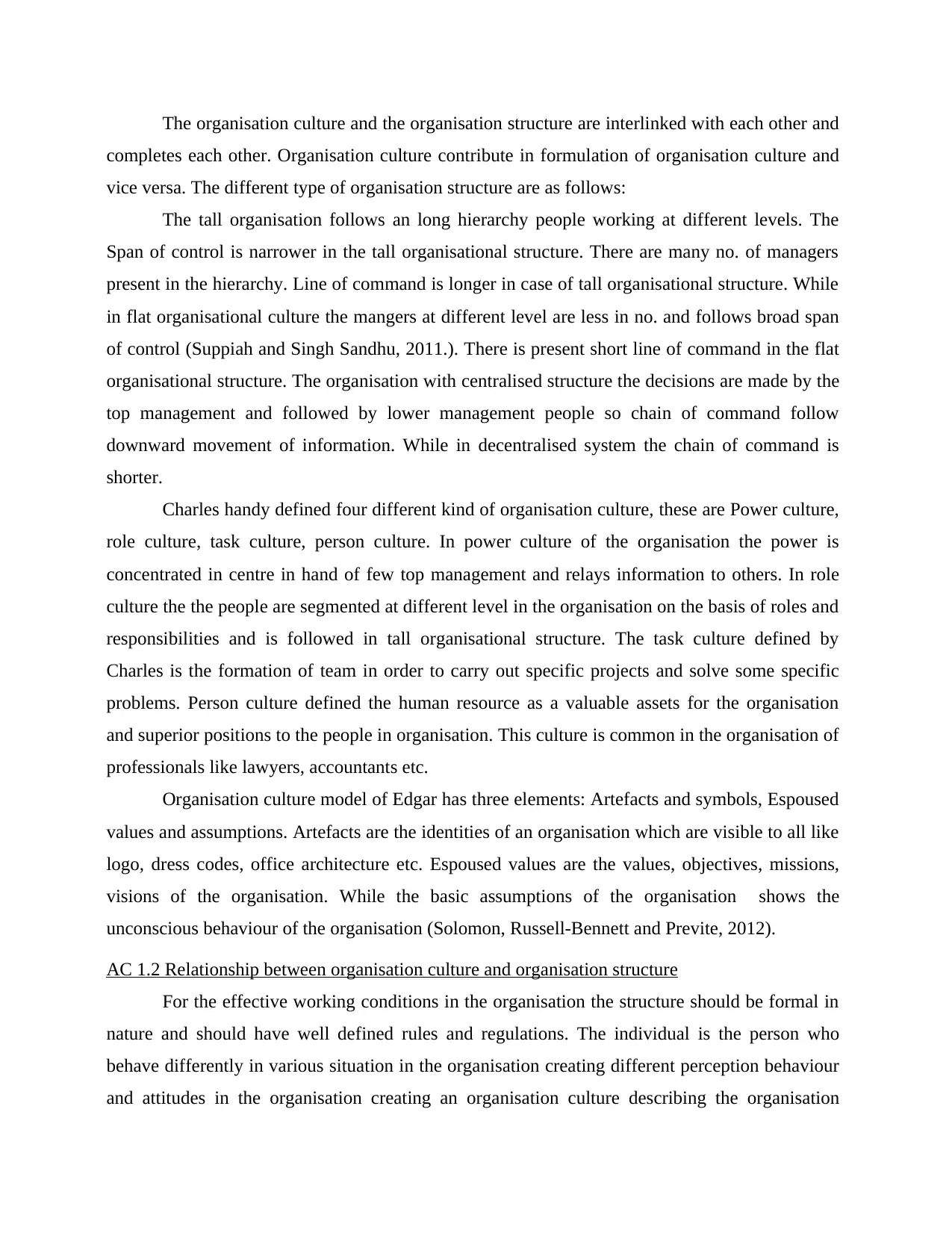
The organisation culture and the organisation structure are interlinked with each other and
completes each other. Organisation culture contribute in formulation of organisation culture and
vice versa. The different type of organisation structure are as follows:
The tall organisation follows an long hierarchy people working at different levels. The
Span of control is narrower in the tall organisational structure. There are many no. of managers
present in the hierarchy. Line of command is longer in case of tall organisational structure. While
in flat organisational culture the mangers at different level are less in no. and follows broad span
of control (Suppiah and Singh Sandhu, 2011.). There is present short line of command in the flat
organisational structure. The organisation with centralised structure the decisions are made by the
top management and followed by lower management people so chain of command follow
downward movement of information. While in decentralised system the chain of command is
shorter.
Charles handy defined four different kind of organisation culture, these are Power culture,
role culture, task culture, person culture. In power culture of the organisation the power is
concentrated in centre in hand of few top management and relays information to others. In role
culture the the people are segmented at different level in the organisation on the basis of roles and
responsibilities and is followed in tall organisational structure. The task culture defined by
Charles is the formation of team in order to carry out specific projects and solve some specific
problems. Person culture defined the human resource as a valuable assets for the organisation
and superior positions to the people in organisation. This culture is common in the organisation of
professionals like lawyers, accountants etc.
Organisation culture model of Edgar has three elements: Artefacts and symbols, Espoused
values and assumptions. Artefacts are the identities of an organisation which are visible to all like
logo, dress codes, office architecture etc. Espoused values are the values, objectives, missions,
visions of the organisation. While the basic assumptions of the organisation shows the
unconscious behaviour of the organisation (Solomon, Russell-Bennett and Previte, 2012).
AC 1.2 Relationship between organisation culture and organisation structure
For the effective working conditions in the organisation the structure should be formal in
nature and should have well defined rules and regulations. The individual is the person who
behave differently in various situation in the organisation creating different perception behaviour
and attitudes in the organisation creating an organisation culture describing the organisation
completes each other. Organisation culture contribute in formulation of organisation culture and
vice versa. The different type of organisation structure are as follows:
The tall organisation follows an long hierarchy people working at different levels. The
Span of control is narrower in the tall organisational structure. There are many no. of managers
present in the hierarchy. Line of command is longer in case of tall organisational structure. While
in flat organisational culture the mangers at different level are less in no. and follows broad span
of control (Suppiah and Singh Sandhu, 2011.). There is present short line of command in the flat
organisational structure. The organisation with centralised structure the decisions are made by the
top management and followed by lower management people so chain of command follow
downward movement of information. While in decentralised system the chain of command is
shorter.
Charles handy defined four different kind of organisation culture, these are Power culture,
role culture, task culture, person culture. In power culture of the organisation the power is
concentrated in centre in hand of few top management and relays information to others. In role
culture the the people are segmented at different level in the organisation on the basis of roles and
responsibilities and is followed in tall organisational structure. The task culture defined by
Charles is the formation of team in order to carry out specific projects and solve some specific
problems. Person culture defined the human resource as a valuable assets for the organisation
and superior positions to the people in organisation. This culture is common in the organisation of
professionals like lawyers, accountants etc.
Organisation culture model of Edgar has three elements: Artefacts and symbols, Espoused
values and assumptions. Artefacts are the identities of an organisation which are visible to all like
logo, dress codes, office architecture etc. Espoused values are the values, objectives, missions,
visions of the organisation. While the basic assumptions of the organisation shows the
unconscious behaviour of the organisation (Solomon, Russell-Bennett and Previte, 2012).
AC 1.2 Relationship between organisation culture and organisation structure
For the effective working conditions in the organisation the structure should be formal in
nature and should have well defined rules and regulations. The individual is the person who
behave differently in various situation in the organisation creating different perception behaviour
and attitudes in the organisation creating an organisation culture describing the organisation
Paraphrase This Document
Need a fresh take? Get an instant paraphrase of this document with our AI Paraphraser
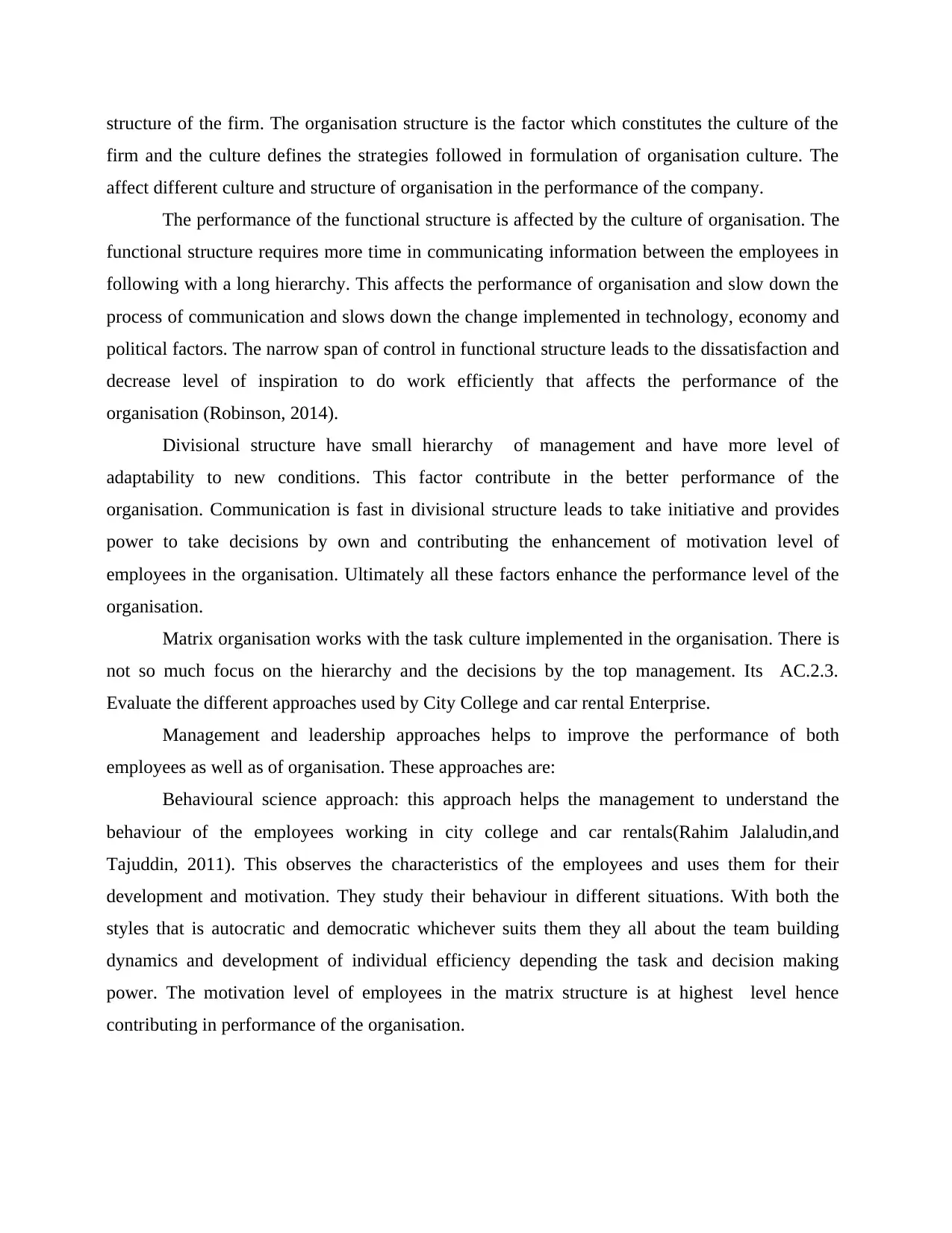
structure of the firm. The organisation structure is the factor which constitutes the culture of the
firm and the culture defines the strategies followed in formulation of organisation culture. The
affect different culture and structure of organisation in the performance of the company.
The performance of the functional structure is affected by the culture of organisation. The
functional structure requires more time in communicating information between the employees in
following with a long hierarchy. This affects the performance of organisation and slow down the
process of communication and slows down the change implemented in technology, economy and
political factors. The narrow span of control in functional structure leads to the dissatisfaction and
decrease level of inspiration to do work efficiently that affects the performance of the
organisation (Robinson, 2014).
Divisional structure have small hierarchy of management and have more level of
adaptability to new conditions. This factor contribute in the better performance of the
organisation. Communication is fast in divisional structure leads to take initiative and provides
power to take decisions by own and contributing the enhancement of motivation level of
employees in the organisation. Ultimately all these factors enhance the performance level of the
organisation.
Matrix organisation works with the task culture implemented in the organisation. There is
not so much focus on the hierarchy and the decisions by the top management. Its AC.2.3.
Evaluate the different approaches used by City College and car rental Enterprise.
Management and leadership approaches helps to improve the performance of both
employees as well as of organisation. These approaches are:
Behavioural science approach: this approach helps the management to understand the
behaviour of the employees working in city college and car rentals(Rahim Jalaludin,and
Tajuddin, 2011). This observes the characteristics of the employees and uses them for their
development and motivation. They study their behaviour in different situations. With both the
styles that is autocratic and democratic whichever suits them they all about the team building
dynamics and development of individual efficiency depending the task and decision making
power. The motivation level of employees in the matrix structure is at highest level hence
contributing in performance of the organisation.
firm and the culture defines the strategies followed in formulation of organisation culture. The
affect different culture and structure of organisation in the performance of the company.
The performance of the functional structure is affected by the culture of organisation. The
functional structure requires more time in communicating information between the employees in
following with a long hierarchy. This affects the performance of organisation and slow down the
process of communication and slows down the change implemented in technology, economy and
political factors. The narrow span of control in functional structure leads to the dissatisfaction and
decrease level of inspiration to do work efficiently that affects the performance of the
organisation (Robinson, 2014).
Divisional structure have small hierarchy of management and have more level of
adaptability to new conditions. This factor contribute in the better performance of the
organisation. Communication is fast in divisional structure leads to take initiative and provides
power to take decisions by own and contributing the enhancement of motivation level of
employees in the organisation. Ultimately all these factors enhance the performance level of the
organisation.
Matrix organisation works with the task culture implemented in the organisation. There is
not so much focus on the hierarchy and the decisions by the top management. Its AC.2.3.
Evaluate the different approaches used by City College and car rental Enterprise.
Management and leadership approaches helps to improve the performance of both
employees as well as of organisation. These approaches are:
Behavioural science approach: this approach helps the management to understand the
behaviour of the employees working in city college and car rentals(Rahim Jalaludin,and
Tajuddin, 2011). This observes the characteristics of the employees and uses them for their
development and motivation. They study their behaviour in different situations. With both the
styles that is autocratic and democratic whichever suits them they all about the team building
dynamics and development of individual efficiency depending the task and decision making
power. The motivation level of employees in the matrix structure is at highest level hence
contributing in performance of the organisation.
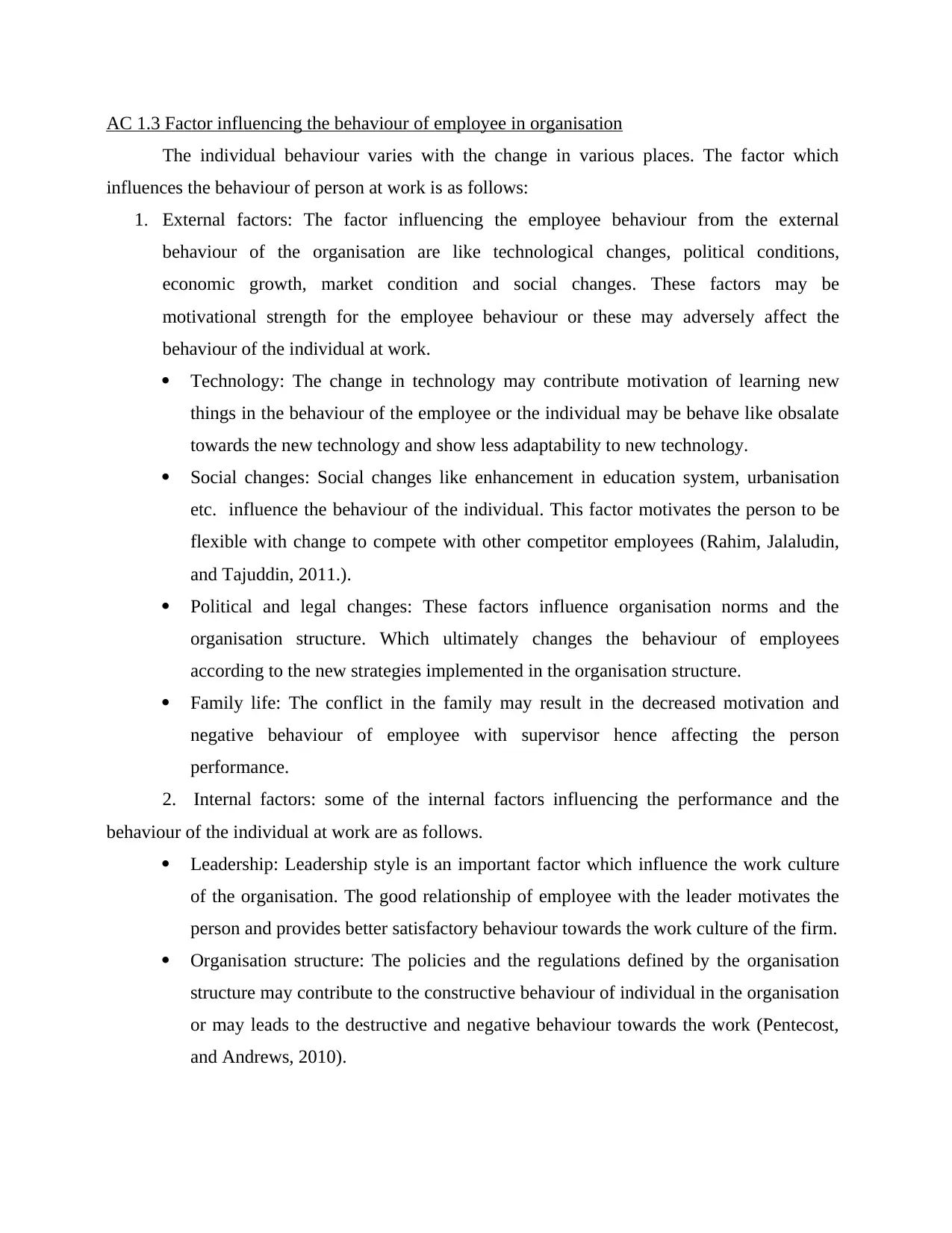
AC 1.3 Factor influencing the behaviour of employee in organisation
The individual behaviour varies with the change in various places. The factor which
influences the behaviour of person at work is as follows:
1. External factors: The factor influencing the employee behaviour from the external
behaviour of the organisation are like technological changes, political conditions,
economic growth, market condition and social changes. These factors may be
motivational strength for the employee behaviour or these may adversely affect the
behaviour of the individual at work.
Technology: The change in technology may contribute motivation of learning new
things in the behaviour of the employee or the individual may be behave like obsalate
towards the new technology and show less adaptability to new technology.
Social changes: Social changes like enhancement in education system, urbanisation
etc. influence the behaviour of the individual. This factor motivates the person to be
flexible with change to compete with other competitor employees (Rahim, Jalaludin,
and Tajuddin, 2011.).
Political and legal changes: These factors influence organisation norms and the
organisation structure. Which ultimately changes the behaviour of employees
according to the new strategies implemented in the organisation structure.
Family life: The conflict in the family may result in the decreased motivation and
negative behaviour of employee with supervisor hence affecting the person
performance.
2. Internal factors: some of the internal factors influencing the performance and the
behaviour of the individual at work are as follows.
Leadership: Leadership style is an important factor which influence the work culture
of the organisation. The good relationship of employee with the leader motivates the
person and provides better satisfactory behaviour towards the work culture of the firm.
Organisation structure: The policies and the regulations defined by the organisation
structure may contribute to the constructive behaviour of individual in the organisation
or may leads to the destructive and negative behaviour towards the work (Pentecost,
and Andrews, 2010).
The individual behaviour varies with the change in various places. The factor which
influences the behaviour of person at work is as follows:
1. External factors: The factor influencing the employee behaviour from the external
behaviour of the organisation are like technological changes, political conditions,
economic growth, market condition and social changes. These factors may be
motivational strength for the employee behaviour or these may adversely affect the
behaviour of the individual at work.
Technology: The change in technology may contribute motivation of learning new
things in the behaviour of the employee or the individual may be behave like obsalate
towards the new technology and show less adaptability to new technology.
Social changes: Social changes like enhancement in education system, urbanisation
etc. influence the behaviour of the individual. This factor motivates the person to be
flexible with change to compete with other competitor employees (Rahim, Jalaludin,
and Tajuddin, 2011.).
Political and legal changes: These factors influence organisation norms and the
organisation structure. Which ultimately changes the behaviour of employees
according to the new strategies implemented in the organisation structure.
Family life: The conflict in the family may result in the decreased motivation and
negative behaviour of employee with supervisor hence affecting the person
performance.
2. Internal factors: some of the internal factors influencing the performance and the
behaviour of the individual at work are as follows.
Leadership: Leadership style is an important factor which influence the work culture
of the organisation. The good relationship of employee with the leader motivates the
person and provides better satisfactory behaviour towards the work culture of the firm.
Organisation structure: The policies and the regulations defined by the organisation
structure may contribute to the constructive behaviour of individual in the organisation
or may leads to the destructive and negative behaviour towards the work (Pentecost,
and Andrews, 2010).
⊘ This is a preview!⊘
Do you want full access?
Subscribe today to unlock all pages.

Trusted by 1+ million students worldwide
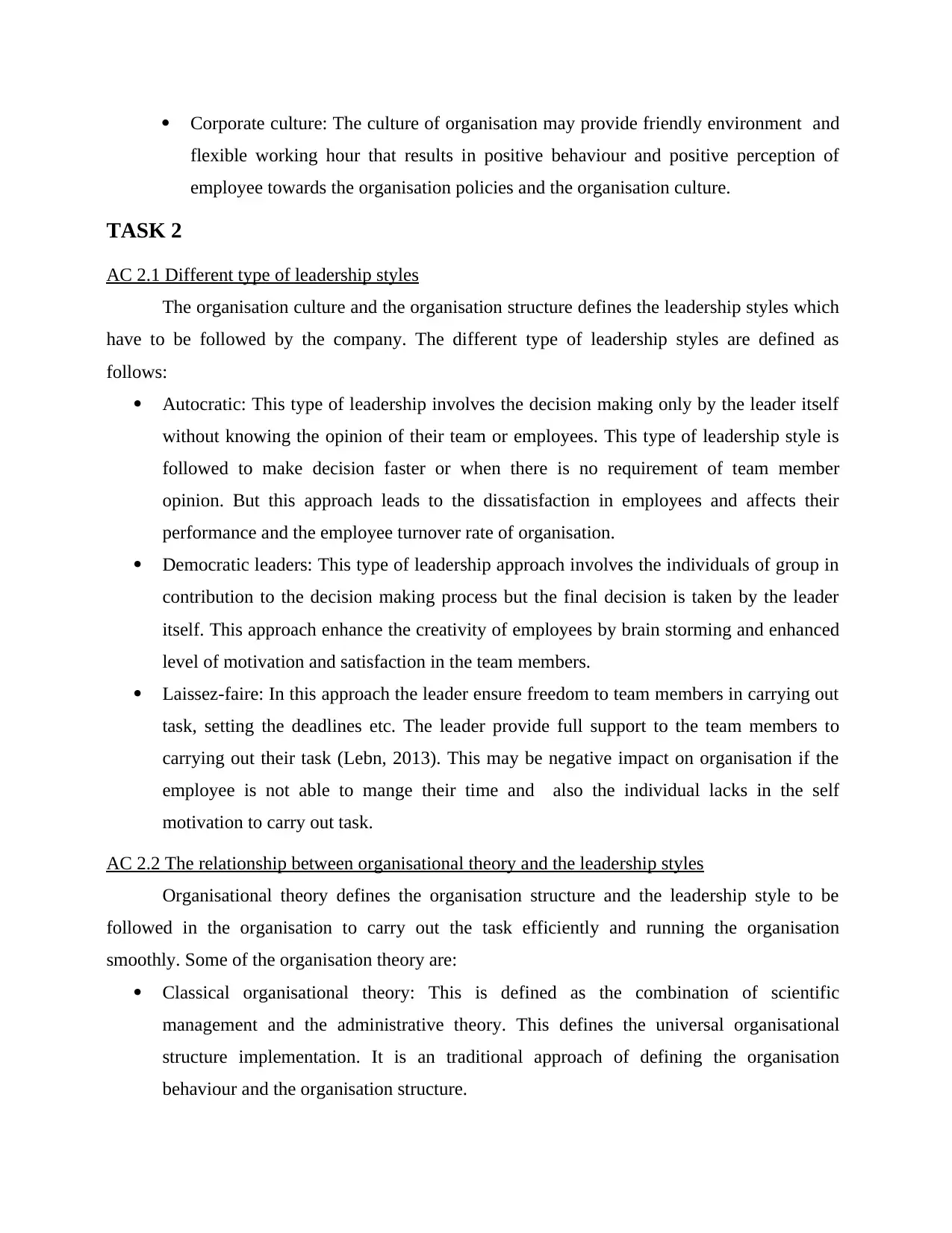
Corporate culture: The culture of organisation may provide friendly environment and
flexible working hour that results in positive behaviour and positive perception of
employee towards the organisation policies and the organisation culture.
TASK 2
AC 2.1 Different type of leadership styles
The organisation culture and the organisation structure defines the leadership styles which
have to be followed by the company. The different type of leadership styles are defined as
follows:
Autocratic: This type of leadership involves the decision making only by the leader itself
without knowing the opinion of their team or employees. This type of leadership style is
followed to make decision faster or when there is no requirement of team member
opinion. But this approach leads to the dissatisfaction in employees and affects their
performance and the employee turnover rate of organisation.
Democratic leaders: This type of leadership approach involves the individuals of group in
contribution to the decision making process but the final decision is taken by the leader
itself. This approach enhance the creativity of employees by brain storming and enhanced
level of motivation and satisfaction in the team members.
Laissez-faire: In this approach the leader ensure freedom to team members in carrying out
task, setting the deadlines etc. The leader provide full support to the team members to
carrying out their task (Lebn, 2013). This may be negative impact on organisation if the
employee is not able to mange their time and also the individual lacks in the self
motivation to carry out task.
AC 2.2 The relationship between organisational theory and the leadership styles
Organisational theory defines the organisation structure and the leadership style to be
followed in the organisation to carry out the task efficiently and running the organisation
smoothly. Some of the organisation theory are:
Classical organisational theory: This is defined as the combination of scientific
management and the administrative theory. This defines the universal organisational
structure implementation. It is an traditional approach of defining the organisation
behaviour and the organisation structure.
flexible working hour that results in positive behaviour and positive perception of
employee towards the organisation policies and the organisation culture.
TASK 2
AC 2.1 Different type of leadership styles
The organisation culture and the organisation structure defines the leadership styles which
have to be followed by the company. The different type of leadership styles are defined as
follows:
Autocratic: This type of leadership involves the decision making only by the leader itself
without knowing the opinion of their team or employees. This type of leadership style is
followed to make decision faster or when there is no requirement of team member
opinion. But this approach leads to the dissatisfaction in employees and affects their
performance and the employee turnover rate of organisation.
Democratic leaders: This type of leadership approach involves the individuals of group in
contribution to the decision making process but the final decision is taken by the leader
itself. This approach enhance the creativity of employees by brain storming and enhanced
level of motivation and satisfaction in the team members.
Laissez-faire: In this approach the leader ensure freedom to team members in carrying out
task, setting the deadlines etc. The leader provide full support to the team members to
carrying out their task (Lebn, 2013). This may be negative impact on organisation if the
employee is not able to mange their time and also the individual lacks in the self
motivation to carry out task.
AC 2.2 The relationship between organisational theory and the leadership styles
Organisational theory defines the organisation structure and the leadership style to be
followed in the organisation to carry out the task efficiently and running the organisation
smoothly. Some of the organisation theory are:
Classical organisational theory: This is defined as the combination of scientific
management and the administrative theory. This defines the universal organisational
structure implementation. It is an traditional approach of defining the organisation
behaviour and the organisation structure.
Paraphrase This Document
Need a fresh take? Get an instant paraphrase of this document with our AI Paraphraser
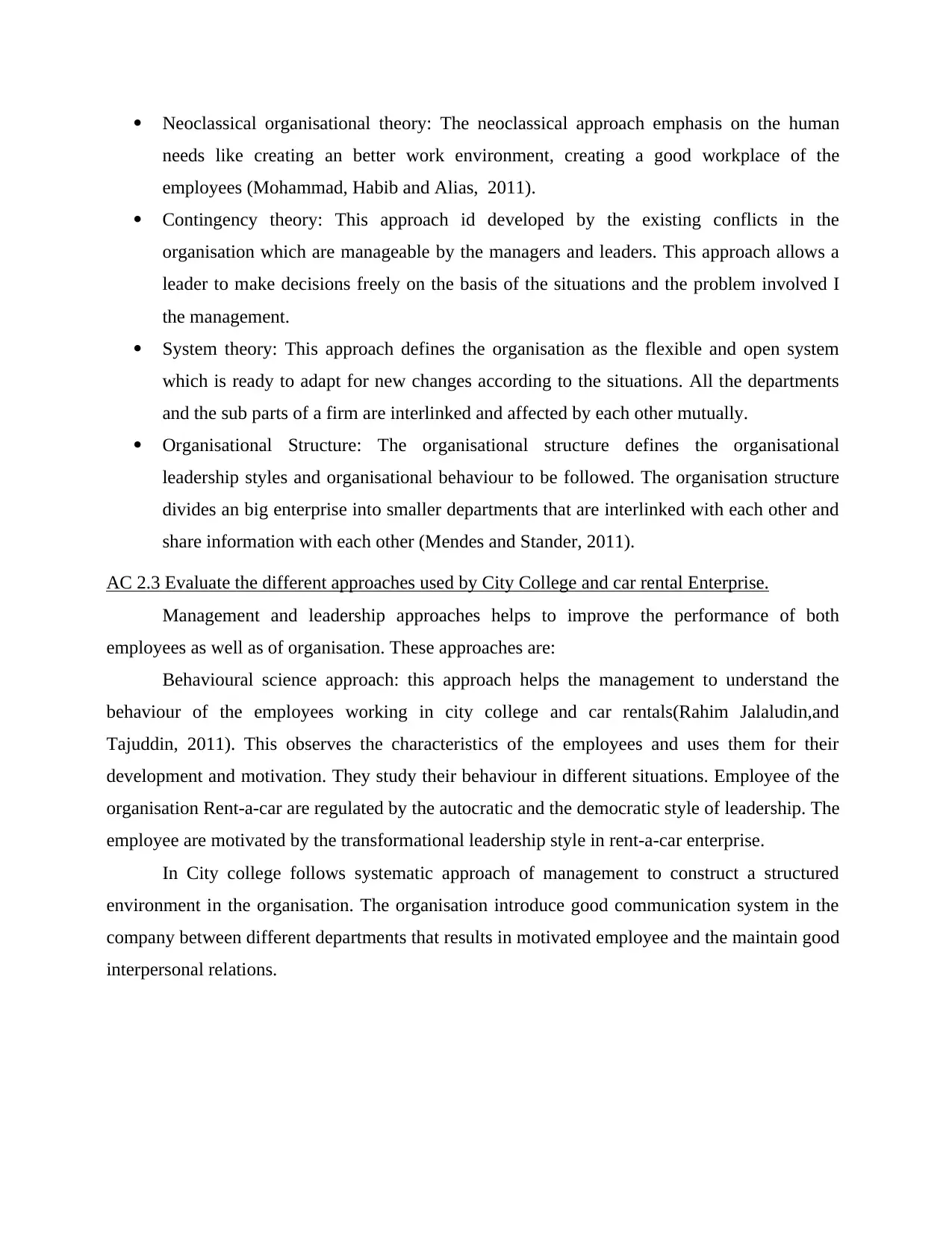
Neoclassical organisational theory: The neoclassical approach emphasis on the human
needs like creating an better work environment, creating a good workplace of the
employees (Mohammad, Habib and Alias, 2011).
Contingency theory: This approach id developed by the existing conflicts in the
organisation which are manageable by the managers and leaders. This approach allows a
leader to make decisions freely on the basis of the situations and the problem involved I
the management.
System theory: This approach defines the organisation as the flexible and open system
which is ready to adapt for new changes according to the situations. All the departments
and the sub parts of a firm are interlinked and affected by each other mutually.
Organisational Structure: The organisational structure defines the organisational
leadership styles and organisational behaviour to be followed. The organisation structure
divides an big enterprise into smaller departments that are interlinked with each other and
share information with each other (Mendes and Stander, 2011).
AC 2.3 Evaluate the different approaches used by City College and car rental Enterprise.
Management and leadership approaches helps to improve the performance of both
employees as well as of organisation. These approaches are:
Behavioural science approach: this approach helps the management to understand the
behaviour of the employees working in city college and car rentals(Rahim Jalaludin,and
Tajuddin, 2011). This observes the characteristics of the employees and uses them for their
development and motivation. They study their behaviour in different situations. Employee of the
organisation Rent-a-car are regulated by the autocratic and the democratic style of leadership. The
employee are motivated by the transformational leadership style in rent-a-car enterprise.
In City college follows systematic approach of management to construct a structured
environment in the organisation. The organisation introduce good communication system in the
company between different departments that results in motivated employee and the maintain good
interpersonal relations.
needs like creating an better work environment, creating a good workplace of the
employees (Mohammad, Habib and Alias, 2011).
Contingency theory: This approach id developed by the existing conflicts in the
organisation which are manageable by the managers and leaders. This approach allows a
leader to make decisions freely on the basis of the situations and the problem involved I
the management.
System theory: This approach defines the organisation as the flexible and open system
which is ready to adapt for new changes according to the situations. All the departments
and the sub parts of a firm are interlinked and affected by each other mutually.
Organisational Structure: The organisational structure defines the organisational
leadership styles and organisational behaviour to be followed. The organisation structure
divides an big enterprise into smaller departments that are interlinked with each other and
share information with each other (Mendes and Stander, 2011).
AC 2.3 Evaluate the different approaches used by City College and car rental Enterprise.
Management and leadership approaches helps to improve the performance of both
employees as well as of organisation. These approaches are:
Behavioural science approach: this approach helps the management to understand the
behaviour of the employees working in city college and car rentals(Rahim Jalaludin,and
Tajuddin, 2011). This observes the characteristics of the employees and uses them for their
development and motivation. They study their behaviour in different situations. Employee of the
organisation Rent-a-car are regulated by the autocratic and the democratic style of leadership. The
employee are motivated by the transformational leadership style in rent-a-car enterprise.
In City college follows systematic approach of management to construct a structured
environment in the organisation. The organisation introduce good communication system in the
company between different departments that results in motivated employee and the maintain good
interpersonal relations.
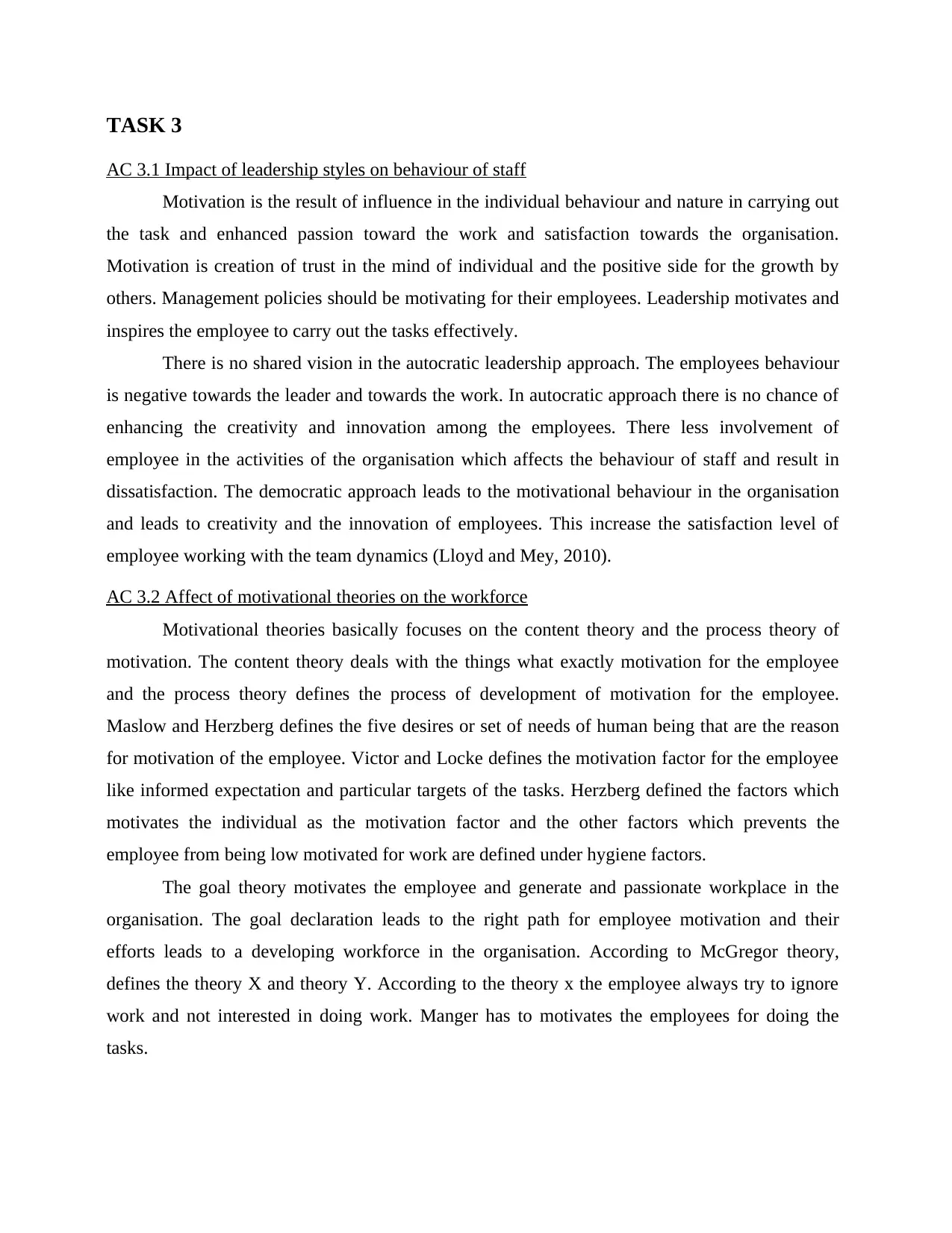
TASK 3
AC 3.1 Impact of leadership styles on behaviour of staff
Motivation is the result of influence in the individual behaviour and nature in carrying out
the task and enhanced passion toward the work and satisfaction towards the organisation.
Motivation is creation of trust in the mind of individual and the positive side for the growth by
others. Management policies should be motivating for their employees. Leadership motivates and
inspires the employee to carry out the tasks effectively.
There is no shared vision in the autocratic leadership approach. The employees behaviour
is negative towards the leader and towards the work. In autocratic approach there is no chance of
enhancing the creativity and innovation among the employees. There less involvement of
employee in the activities of the organisation which affects the behaviour of staff and result in
dissatisfaction. The democratic approach leads to the motivational behaviour in the organisation
and leads to creativity and the innovation of employees. This increase the satisfaction level of
employee working with the team dynamics (Lloyd and Mey, 2010).
AC 3.2 Affect of motivational theories on the workforce
Motivational theories basically focuses on the content theory and the process theory of
motivation. The content theory deals with the things what exactly motivation for the employee
and the process theory defines the process of development of motivation for the employee.
Maslow and Herzberg defines the five desires or set of needs of human being that are the reason
for motivation of the employee. Victor and Locke defines the motivation factor for the employee
like informed expectation and particular targets of the tasks. Herzberg defined the factors which
motivates the individual as the motivation factor and the other factors which prevents the
employee from being low motivated for work are defined under hygiene factors.
The goal theory motivates the employee and generate and passionate workplace in the
organisation. The goal declaration leads to the right path for employee motivation and their
efforts leads to a developing workforce in the organisation. According to McGregor theory,
defines the theory X and theory Y. According to the theory x the employee always try to ignore
work and not interested in doing work. Manger has to motivates the employees for doing the
tasks.
AC 3.1 Impact of leadership styles on behaviour of staff
Motivation is the result of influence in the individual behaviour and nature in carrying out
the task and enhanced passion toward the work and satisfaction towards the organisation.
Motivation is creation of trust in the mind of individual and the positive side for the growth by
others. Management policies should be motivating for their employees. Leadership motivates and
inspires the employee to carry out the tasks effectively.
There is no shared vision in the autocratic leadership approach. The employees behaviour
is negative towards the leader and towards the work. In autocratic approach there is no chance of
enhancing the creativity and innovation among the employees. There less involvement of
employee in the activities of the organisation which affects the behaviour of staff and result in
dissatisfaction. The democratic approach leads to the motivational behaviour in the organisation
and leads to creativity and the innovation of employees. This increase the satisfaction level of
employee working with the team dynamics (Lloyd and Mey, 2010).
AC 3.2 Affect of motivational theories on the workforce
Motivational theories basically focuses on the content theory and the process theory of
motivation. The content theory deals with the things what exactly motivation for the employee
and the process theory defines the process of development of motivation for the employee.
Maslow and Herzberg defines the five desires or set of needs of human being that are the reason
for motivation of the employee. Victor and Locke defines the motivation factor for the employee
like informed expectation and particular targets of the tasks. Herzberg defined the factors which
motivates the individual as the motivation factor and the other factors which prevents the
employee from being low motivated for work are defined under hygiene factors.
The goal theory motivates the employee and generate and passionate workplace in the
organisation. The goal declaration leads to the right path for employee motivation and their
efforts leads to a developing workforce in the organisation. According to McGregor theory,
defines the theory X and theory Y. According to the theory x the employee always try to ignore
work and not interested in doing work. Manger has to motivates the employees for doing the
tasks.
⊘ This is a preview!⊘
Do you want full access?
Subscribe today to unlock all pages.

Trusted by 1+ million students worldwide
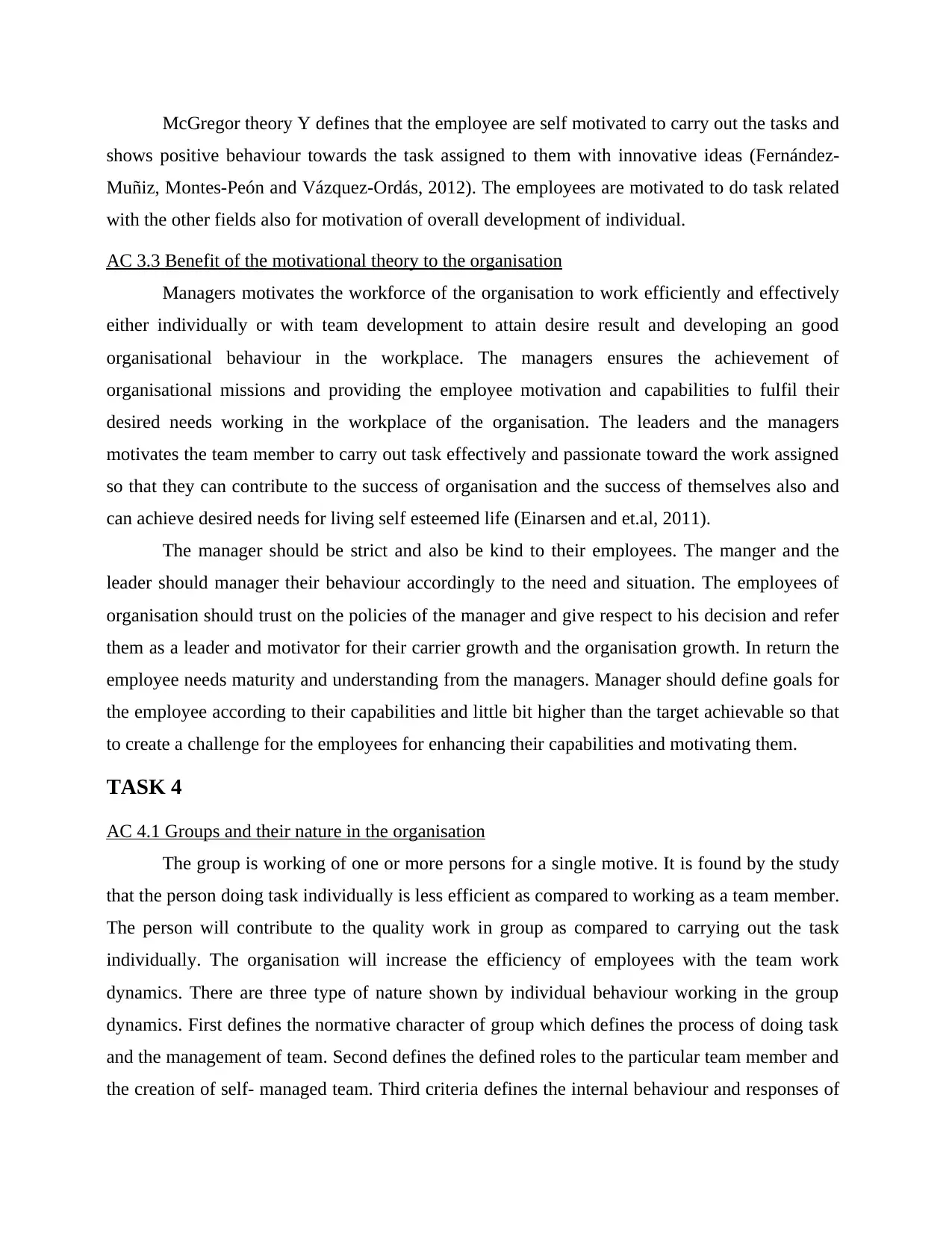
McGregor theory Y defines that the employee are self motivated to carry out the tasks and
shows positive behaviour towards the task assigned to them with innovative ideas (Fernández-
Muñiz, Montes-Peón and Vázquez-Ordás, 2012). The employees are motivated to do task related
with the other fields also for motivation of overall development of individual.
AC 3.3 Benefit of the motivational theory to the organisation
Managers motivates the workforce of the organisation to work efficiently and effectively
either individually or with team development to attain desire result and developing an good
organisational behaviour in the workplace. The managers ensures the achievement of
organisational missions and providing the employee motivation and capabilities to fulfil their
desired needs working in the workplace of the organisation. The leaders and the managers
motivates the team member to carry out task effectively and passionate toward the work assigned
so that they can contribute to the success of organisation and the success of themselves also and
can achieve desired needs for living self esteemed life (Einarsen and et.al, 2011).
The manager should be strict and also be kind to their employees. The manger and the
leader should manager their behaviour accordingly to the need and situation. The employees of
organisation should trust on the policies of the manager and give respect to his decision and refer
them as a leader and motivator for their carrier growth and the organisation growth. In return the
employee needs maturity and understanding from the managers. Manager should define goals for
the employee according to their capabilities and little bit higher than the target achievable so that
to create a challenge for the employees for enhancing their capabilities and motivating them.
TASK 4
AC 4.1 Groups and their nature in the organisation
The group is working of one or more persons for a single motive. It is found by the study
that the person doing task individually is less efficient as compared to working as a team member.
The person will contribute to the quality work in group as compared to carrying out the task
individually. The organisation will increase the efficiency of employees with the team work
dynamics. There are three type of nature shown by individual behaviour working in the group
dynamics. First defines the normative character of group which defines the process of doing task
and the management of team. Second defines the defined roles to the particular team member and
the creation of self- managed team. Third criteria defines the internal behaviour and responses of
shows positive behaviour towards the task assigned to them with innovative ideas (Fernández-
Muñiz, Montes-Peón and Vázquez-Ordás, 2012). The employees are motivated to do task related
with the other fields also for motivation of overall development of individual.
AC 3.3 Benefit of the motivational theory to the organisation
Managers motivates the workforce of the organisation to work efficiently and effectively
either individually or with team development to attain desire result and developing an good
organisational behaviour in the workplace. The managers ensures the achievement of
organisational missions and providing the employee motivation and capabilities to fulfil their
desired needs working in the workplace of the organisation. The leaders and the managers
motivates the team member to carry out task effectively and passionate toward the work assigned
so that they can contribute to the success of organisation and the success of themselves also and
can achieve desired needs for living self esteemed life (Einarsen and et.al, 2011).
The manager should be strict and also be kind to their employees. The manger and the
leader should manager their behaviour accordingly to the need and situation. The employees of
organisation should trust on the policies of the manager and give respect to his decision and refer
them as a leader and motivator for their carrier growth and the organisation growth. In return the
employee needs maturity and understanding from the managers. Manager should define goals for
the employee according to their capabilities and little bit higher than the target achievable so that
to create a challenge for the employees for enhancing their capabilities and motivating them.
TASK 4
AC 4.1 Groups and their nature in the organisation
The group is working of one or more persons for a single motive. It is found by the study
that the person doing task individually is less efficient as compared to working as a team member.
The person will contribute to the quality work in group as compared to carrying out the task
individually. The organisation will increase the efficiency of employees with the team work
dynamics. There are three type of nature shown by individual behaviour working in the group
dynamics. First defines the normative character of group which defines the process of doing task
and the management of team. Second defines the defined roles to the particular team member and
the creation of self- managed team. Third criteria defines the internal behaviour and responses of
Paraphrase This Document
Need a fresh take? Get an instant paraphrase of this document with our AI Paraphraser
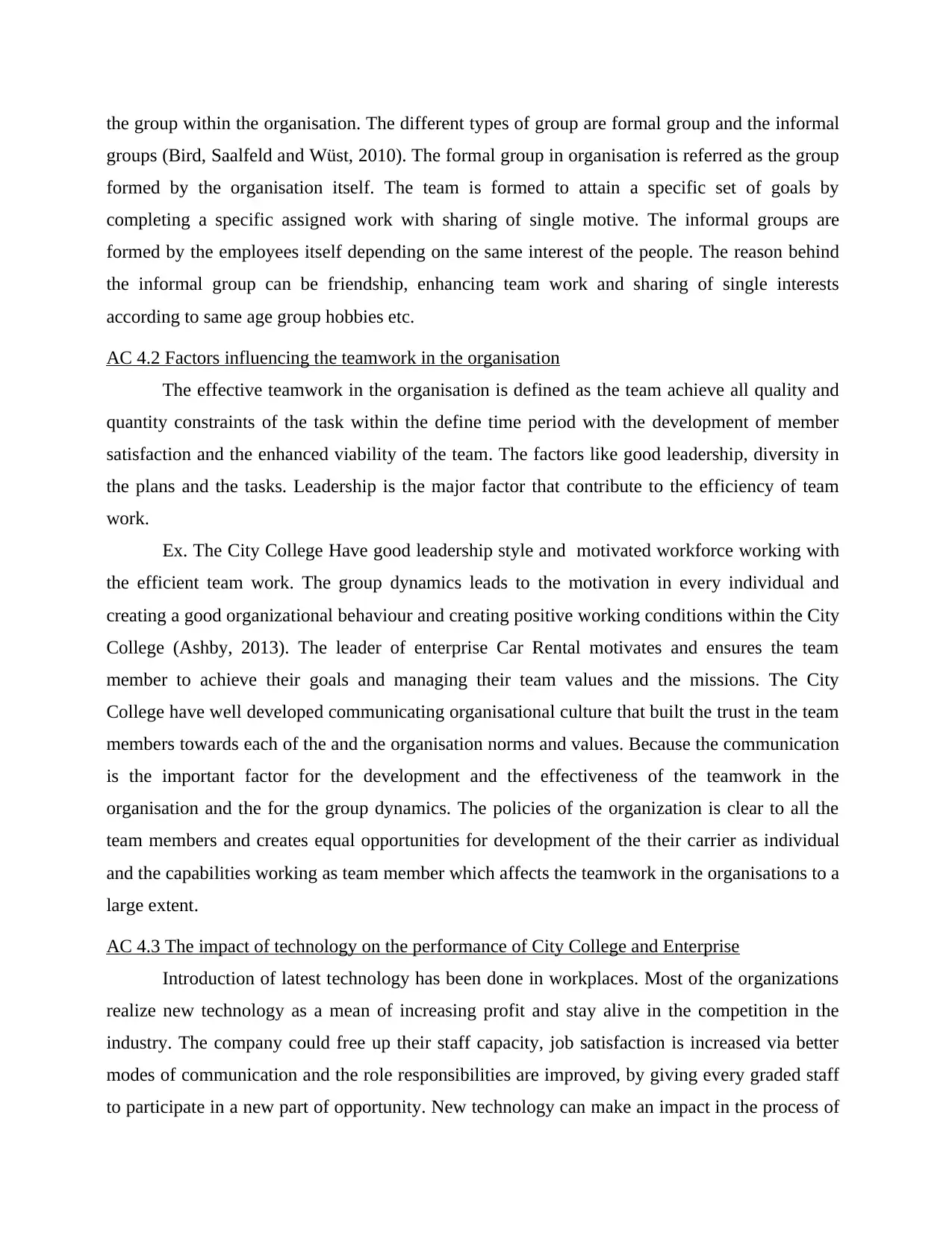
the group within the organisation. The different types of group are formal group and the informal
groups (Bird, Saalfeld and Wüst, 2010). The formal group in organisation is referred as the group
formed by the organisation itself. The team is formed to attain a specific set of goals by
completing a specific assigned work with sharing of single motive. The informal groups are
formed by the employees itself depending on the same interest of the people. The reason behind
the informal group can be friendship, enhancing team work and sharing of single interests
according to same age group hobbies etc.
AC 4.2 Factors influencing the teamwork in the organisation
The effective teamwork in the organisation is defined as the team achieve all quality and
quantity constraints of the task within the define time period with the development of member
satisfaction and the enhanced viability of the team. The factors like good leadership, diversity in
the plans and the tasks. Leadership is the major factor that contribute to the efficiency of team
work.
Ex. The City College Have good leadership style and motivated workforce working with
the efficient team work. The group dynamics leads to the motivation in every individual and
creating a good organizational behaviour and creating positive working conditions within the City
College (Ashby, 2013). The leader of enterprise Car Rental motivates and ensures the team
member to achieve their goals and managing their team values and the missions. The City
College have well developed communicating organisational culture that built the trust in the team
members towards each of the and the organisation norms and values. Because the communication
is the important factor for the development and the effectiveness of the teamwork in the
organisation and the for the group dynamics. The policies of the organization is clear to all the
team members and creates equal opportunities for development of the their carrier as individual
and the capabilities working as team member which affects the teamwork in the organisations to a
large extent.
AC 4.3 The impact of technology on the performance of City College and Enterprise
Introduction of latest technology has been done in workplaces. Most of the organizations
realize new technology as a mean of increasing profit and stay alive in the competition in the
industry. The company could free up their staff capacity, job satisfaction is increased via better
modes of communication and the role responsibilities are improved, by giving every graded staff
to participate in a new part of opportunity. New technology can make an impact in the process of
groups (Bird, Saalfeld and Wüst, 2010). The formal group in organisation is referred as the group
formed by the organisation itself. The team is formed to attain a specific set of goals by
completing a specific assigned work with sharing of single motive. The informal groups are
formed by the employees itself depending on the same interest of the people. The reason behind
the informal group can be friendship, enhancing team work and sharing of single interests
according to same age group hobbies etc.
AC 4.2 Factors influencing the teamwork in the organisation
The effective teamwork in the organisation is defined as the team achieve all quality and
quantity constraints of the task within the define time period with the development of member
satisfaction and the enhanced viability of the team. The factors like good leadership, diversity in
the plans and the tasks. Leadership is the major factor that contribute to the efficiency of team
work.
Ex. The City College Have good leadership style and motivated workforce working with
the efficient team work. The group dynamics leads to the motivation in every individual and
creating a good organizational behaviour and creating positive working conditions within the City
College (Ashby, 2013). The leader of enterprise Car Rental motivates and ensures the team
member to achieve their goals and managing their team values and the missions. The City
College have well developed communicating organisational culture that built the trust in the team
members towards each of the and the organisation norms and values. Because the communication
is the important factor for the development and the effectiveness of the teamwork in the
organisation and the for the group dynamics. The policies of the organization is clear to all the
team members and creates equal opportunities for development of the their carrier as individual
and the capabilities working as team member which affects the teamwork in the organisations to a
large extent.
AC 4.3 The impact of technology on the performance of City College and Enterprise
Introduction of latest technology has been done in workplaces. Most of the organizations
realize new technology as a mean of increasing profit and stay alive in the competition in the
industry. The company could free up their staff capacity, job satisfaction is increased via better
modes of communication and the role responsibilities are improved, by giving every graded staff
to participate in a new part of opportunity. New technology can make an impact in the process of
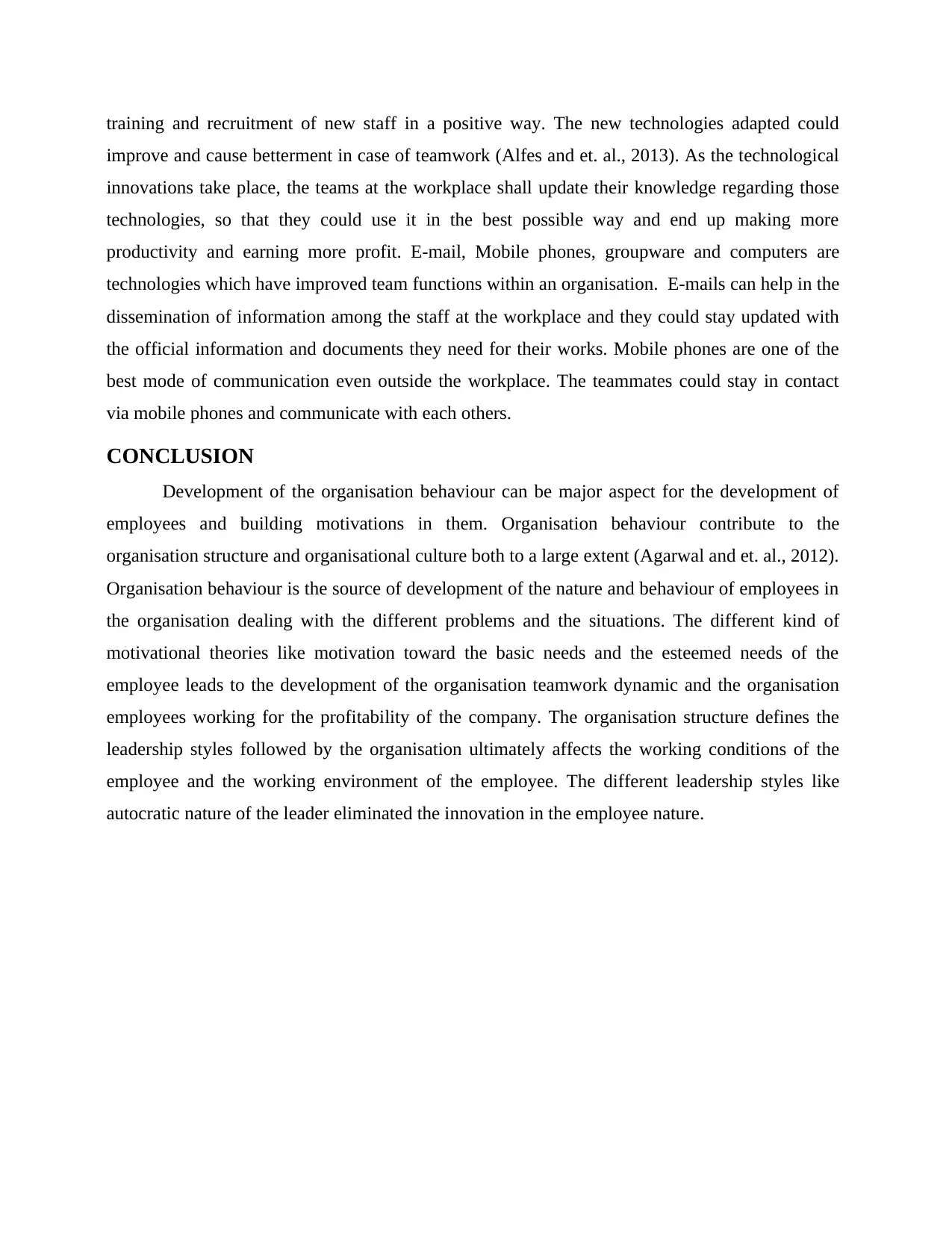
training and recruitment of new staff in a positive way. The new technologies adapted could
improve and cause betterment in case of teamwork (Alfes and et. al., 2013). As the technological
innovations take place, the teams at the workplace shall update their knowledge regarding those
technologies, so that they could use it in the best possible way and end up making more
productivity and earning more profit. E-mail, Mobile phones, groupware and computers are
technologies which have improved team functions within an organisation. E-mails can help in the
dissemination of information among the staff at the workplace and they could stay updated with
the official information and documents they need for their works. Mobile phones are one of the
best mode of communication even outside the workplace. The teammates could stay in contact
via mobile phones and communicate with each others.
CONCLUSION
Development of the organisation behaviour can be major aspect for the development of
employees and building motivations in them. Organisation behaviour contribute to the
organisation structure and organisational culture both to a large extent (Agarwal and et. al., 2012).
Organisation behaviour is the source of development of the nature and behaviour of employees in
the organisation dealing with the different problems and the situations. The different kind of
motivational theories like motivation toward the basic needs and the esteemed needs of the
employee leads to the development of the organisation teamwork dynamic and the organisation
employees working for the profitability of the company. The organisation structure defines the
leadership styles followed by the organisation ultimately affects the working conditions of the
employee and the working environment of the employee. The different leadership styles like
autocratic nature of the leader eliminated the innovation in the employee nature.
improve and cause betterment in case of teamwork (Alfes and et. al., 2013). As the technological
innovations take place, the teams at the workplace shall update their knowledge regarding those
technologies, so that they could use it in the best possible way and end up making more
productivity and earning more profit. E-mail, Mobile phones, groupware and computers are
technologies which have improved team functions within an organisation. E-mails can help in the
dissemination of information among the staff at the workplace and they could stay updated with
the official information and documents they need for their works. Mobile phones are one of the
best mode of communication even outside the workplace. The teammates could stay in contact
via mobile phones and communicate with each others.
CONCLUSION
Development of the organisation behaviour can be major aspect for the development of
employees and building motivations in them. Organisation behaviour contribute to the
organisation structure and organisational culture both to a large extent (Agarwal and et. al., 2012).
Organisation behaviour is the source of development of the nature and behaviour of employees in
the organisation dealing with the different problems and the situations. The different kind of
motivational theories like motivation toward the basic needs and the esteemed needs of the
employee leads to the development of the organisation teamwork dynamic and the organisation
employees working for the profitability of the company. The organisation structure defines the
leadership styles followed by the organisation ultimately affects the working conditions of the
employee and the working environment of the employee. The different leadership styles like
autocratic nature of the leader eliminated the innovation in the employee nature.
⊘ This is a preview!⊘
Do you want full access?
Subscribe today to unlock all pages.

Trusted by 1+ million students worldwide
1 out of 14
Related Documents
Your All-in-One AI-Powered Toolkit for Academic Success.
+13062052269
info@desklib.com
Available 24*7 on WhatsApp / Email
![[object Object]](/_next/static/media/star-bottom.7253800d.svg)
Unlock your academic potential
Copyright © 2020–2025 A2Z Services. All Rights Reserved. Developed and managed by ZUCOL.





